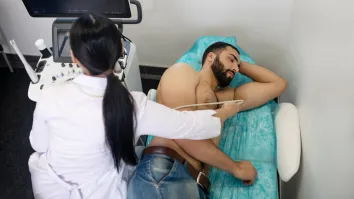
Who’s winning the $10.8bn Asian mHealth race?
While Asian governments and users recognize the efficiency of eHealth programmes, eHealth is still in the early stages of adoption.
Despite being late to the eHealth race, Asian countries are not only catching up and are leading the world in eHealth programme implementations. Asia is also seeing a record increase in mHealth applications and investments owing to its maturing demographics and widening access to mobile devices. Nations in Southern Asia and Eastern Asia and the Pacific, in particular, are implementing the highest percent of technology-enabled health programmes, according to data from the Center for Health Market Innovations.
The World Health Organization (WHO) says these low- and middle-income governments are using information and communication technology (ICT) specifically to improve their health programmes. They do so because of six major benefits: to extend geographic access to health services, facilitate patient communications, improve diagnosis and treatment, improve data management, streamline financial transactions, and mitigate fraud abuse.
Asian governments are fast recognizing the improved efficiency and effectiveness of eHealth programmes, and are funding more of them each year. This in part has convinced corporations and entrepreneurs to venture into the lucrative billion-dollar industry.
mHealth boom
Mobile healthcare or mHealth is an especially promising eHealth segment, according to technology leaders, reflected in the number of mHealth apps and solutions coming to market. “With no doubt, the most important industry trend to watch is mobile mHealth,” says Karthik Tirupathi, CEO of Napier Healthcare, an integrated healthcare information technology company.
Tirupathi cites a Transparency Market Research forecast that the global mHealth market will grow in the next five years to reach $10.2 billion by 2018, up from $1.3 billion in 2012, at a compounded annual rate of 41.5 percent.
Vitalstrak app
With more Asians starting to own smartphones and tablets due to the wide availability and decreasing prices of such devices, Health apps such as Vitalstrak and DocDoc have emerged to satisfy their need to access healthcare information in the comfort of their homes without having to visit the doctor’s clinic or hospital.
The founders of Vitalstrak mobile app invested more than 10-man years developing it for users who self-manage their health, according to Peter Soh, Co-founder and Executive Director of Vitalstrak, a cloud-based mobile health (mHealth) solution for chronic health and medication management. Soh says the app came about amid a growing number of elderly and individuals suffering from so-called chronic ‘lifestyle’ diseases in Southeast Asia and Hong Kong. “Healthcare professionals can use it to remotely monitor patients with special care needs. Just like legacy telehealth systems, it also allows large healthcare institutions to provide integrated care for patients with multiple health disorders as each department can personalize its treatment plan in coordination with other departments,” he adds.
DocDoc app
Another example is the DocDoc app, which offers a free online finder service to patients looking for qualified doctors and dentists. Instead of having to call hospitals or look up directories, a user can access the DocDoc app (or browser for those who do not own smartphones) to search for doctors or dentists, review their qualifications, and book a doctor’s appointment. Near the appointment date, DocDoc users will even receive automated reminders.
DocDoc complements its online service with a free, appointment-by-phone concierge service for those who want to find and consult with a doctor over the phone.
“Our concierge service provides a convenient way for patients to find the right doctor or dentist by phone, get matched by location, medical specialty, or other factors and get live assistance from experienced support staff,” says Max-F. Scheichenost, Co-Founder & President of DocDoc Pte Ltd, which has raised approximately $5 million for its systems, websites, databases and administrative tools.
With mHealth apps, Asians can spend a few minutes on their smartphones and find doctors, schedule check-ups, receive health and wellness advice, and track their vitals and medicine intake.
But where Asia – and the rest of the world – is headed involves far more than remotely accessing information. This future is called the digital hospital, according to HP’s eHealth division. “A digital hospital is a patient-centric healthcare environment in which all systems – clinical, business, and facility – fully integrate and connect, enabling information to flow seamlessly and securely among departments and personnel,” says Wesley J. Krumel, chief architect and IT strategist for HP’s worldwide eHealth solutions.
In its most realized form, HP envisions the digital hospital as being able to admit surgery patients with radio frequency identification. Critical data required for the operation such as necessary labs, images and the patient’s electronic health record (EHR) are then automatically sent to operating room. During the procedure, loved ones will be given a tablet computer that updates the status straight from the operating room doctors. After the procedure, vitals are sent in real-time to the patient’s doctor, who can then remotely observe his recovery.
EHR in Asia
The EHR, a fundamental part of the digital hospital, is still in the very early stages of adoption in Asia. “Government healthcare institutions worldwide are moving towards the goal of a single health record for each citizen that can be used across healthcare providers,” notes Tirupathi of Napier Healthcare, a Singapore-headquartered EHR mobile (EHRm) vendor. “In Asia, government healthcare groups and private health networks are still running separate patient record systems and operating on different levels of record management integration.”
But several pioneering hospitals such as Jaslok Hospital in Mumbai are moving ahead of the curve and shifting to digital patient record that can be easily and securely shared. Jaslok is in the process of implementing Napier’s open-source based EHRm platform, which Tirupathi says will give the hospital “anywhere, anytime accessibility” to patient EHRs for the 1,100 users, consisting of doctors, management and patients. Given the perceived high cost and minimal benefits of adopting an EHRm platform, Napier Healthcare goes the extra mile in scaling their solutions to widen their potential market beyond large, cash-flush hospitals.
“It can be a challenge to get private hospitals and general physicians to come onboard the EHR initiative as there are no tangible incentives coupled with costs incurrence,” says Tirupathi.
Still, despite the admirable strides of eHealth in emerging Asia with the proliferation of mHealth apps and pockets of EHR adoption by hospitals, it has a long road ahead before it reaches mass implementation that leads to the creation of digital hospitals. “Despite the increased interest in some individual programmes, in low- and middle-income countries the eHealth field is still relatively nascent,” opined the World Health Organization in its 2011 bulletin. “To date, the literature on eHealth in low- and middle-income countries has largely consisted of articles describing single uses of technology in health care delivery.”
The Southeast Asia region, in particular, faces seven key challenges around eHealth, said WHO in a regional workshop in late September: lack of eHealth policy, strategy and legal framework to support the national health system; uncoordinated investment in ICT in health due to the absence of an overarching plan for eHealth; duplication of efforts due to a low degree of cooperation, collaboration and sharing across sectors; limited capacity within the public sector to implement eHealth programs; widely differing levels of eHealth maturity across and within countries; poor quality and disparities in data with health information systems existing in silos - segmented with little interoperability and communication; and poor communication infrastructure and lack of broadband connectivity and internet access.
eHealth companies added that resistance to change, poor clinical trial support, and obsolete regulations are also crimping the pace of development and adoption of eHealth solutions. “Policy makers and healthcare professionals are slow to embrace disruptive technology like mobile technology in chronic care management, unlike their peers in the Western nations,” said Vitalstrak’s Soh.



















 Advertise
Advertise





